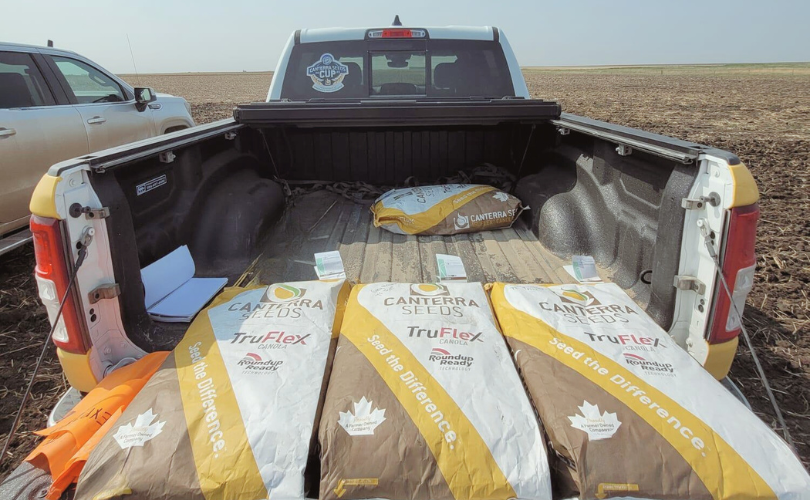Ah, the age-old question - does size matter?
When it comes to canola seeds, size isn’t everything. Let’s dive into the fascinating world of canola planting, shall we?
First, let’s dispel a common myth: the size of canola seeds—often measured as "thousand seed weight" (TSW)—doesn’t have a significant impact on emergence, yield, or seed quality. Whether you’re dealing with larger or smaller seeds, they all have a similar ability to absorb moisture, germinate, and emerge evenly. A 2014 study by Dr. Neil Harker from AAFC confirmed this. In my experience, the more critical factors are germination rate, seed coat integrity, green seed or chlorophyll content, and the presence of seed-borne diseases. To mitigate these risks, CANTERRA SEEDS implements a rigorous seed testing program at multiple stages: post-harvest, after cleaning, and again after treating and packaging the seeds. This ensures that every seed lot we sell is primed for success—before it even leaves our hands.
So why do we care about seed size? Well, where seed size matters more is when determining the right seeding rate. For the 2024-25 season, CANTERRA SEEDS is shifting to selling 4.25 million seeds per bag, moving away from the traditional 22.7 kg unit. This change offers our customers greater predictability and precision in seeding decisions. According to the Canola Council of Canada, the ideal plant stand is between 5 to 8 plants per square foot (217,800 to 348,480 plants per acre), depending on factors like field location, specific conditions, and individual management practices.
For example, if Farmer A in central Saskatchewan decides to plant his canola crop early, with soil temperatures below 5°C, but has excellent seedbed conditions and a strong crop rotation, he might aim for a plant stand of 6 plants per square foot with an expected seedling survivability of 50%. Farmer B, who waits for a week and plants at soil temperatures above 10°C, might expect a survivability rate of 60% while targeting the same plant stand. Both farmers would use the following formula to calculate their seeding rate:
Seeding Rate (lbs/acre) = Desired Plant Population (plants/sq. ft) x TSW (grams) / Survival Rate (%) / 10.4
If Farmer A is using a seed lot with a TSW of 5.0 grams, his calculation would be:
6 plants/sq. ft x 5.0 grams / 50% / 10.4 = 5.8 lbs/acre
Farmer B, using a seed lot with a large seed size 6.0 grams TSW, would arrive at a similar seeding rate:
6 plants/sq. ft x 6.0 grams / 60% / 10.4 = 5.8 lbs/acre
As this example shows, soil temperature is another key factor in determining seedling survivability. Canola seeds start germinating at 5°C and start growing optimally at 10°C.
There are other crucial factors to consider, too. The type of planting equipment can significantly impact crop establishment, especially with the increasing use of precision planting technology. Through our partnership with Syngenta Canada, we offer Pelta™ on select canola hybrids, along with other options for ease of seeding with a planter. For more details on accessing uniformly sized seeds and calculating seeding rates for row cropping canola, contact your local CANTERRA SEEDS Territory Manager.
Another important farmer-directed decision is seeding depth. Canola seed prefers to be planted at a depth of ½ to 1 inch. Any deeper, and it can hinder their ability to reach the soil surface, especially if wind fills furrows extending the emergence zone to two inches or more. While deeper planting might seem necessary to reach moisture, it exposes seedlings to additional stresses, such as prolonged emergence times and increased susceptibility to root rot. The longer it takes for a seedling to break the surface, the more vulnerable it is to challenges like flea beetles, wind damage and damage from wind-blown soil particles and frost—factors that could push the crop perilously close to needing reseeding.
Selecting seeds with the right treatments is essential to protect against early-season biotic stresses. At CANTERRA SEEDS, we’re committed to offering the best seed treatments on the market. For the 2024-25 season, we’ll provide advanced treatment combinations that offer strong protection against seedling root rot, early blackleg, flea beetles, and cutworms, including:
- Helix Saltro®
- Helix Saltro® + BUTEO start®
- Helix Saltro® + BUTEO start® + Fortenza®
- Helix Saltro® + Fortenza Advanced ®
Quality seed starts with rigorous grading—ensuring the pedigreed grade assigned is CANADA Certified No. 1, as indicated on the official CFIA tag affixed to every package of canola seed.
At CANTERRA SEEDS, we’re committed to helping our customers make informed decisions. Each of our seed bags features a table on the back that details the seeding rate in pounds per acre needed to achieve the desired plant stand, based on expected seedling survivability and thousand seed weight. The thousand seed weight is also printed on the front of each bag for easy reference. For even more precision, a QR code on the bag leads to detailed seed weight information for each lot after final packaging. These measures ensure our customers can fine-tune their seeding rates for optimal crop establishment.
So, while many factors influence early-season canola crop establishment, seed size is one of the least concerning. As we’ve highlighted, there are far more critical considerations to keep in mind, and seed size simply isn’t one of them.


